The History of Greece, a brief look at Ancient Greece and the Greek mythological figures.
Ancient Greece is the civilisation belonging to the period of Greek history lasting from the Archaic period of the 8th to 6th centuries BC to 146 BC and the Roman conquest of Greece after the Battle of Corinth.
The history of Greece can be traced back to Stone Age hunters. Later came early farmers and the civilizations of the Minoan and Mycenaean kings. This was followed by a period of wars and invasions, known as the Dark Ages. In about 1100 BC, a people tribe called the Dorians, invaded from the north and spread down the west coast. In the period from 500-336 BC ancient Greece was divided into small city states, each of which consisted of a city and its surrounding countryside.
Neolithic Period (6800-3300BC) Ancient Greece
Neolithic greek Civilization is the long era, the main characteristics of which are farming , stock-breeding , permanent installation and the extensive use of stone , as well. From the stage of the nomadic hunter-gatherer (Palaeolithic Era ) man entered the stage of farmer-husbandman and dominated his natural environment. This neolithic "revolution" is affected at the beginning of the 7th millennium. The neolithic Civilization lasted more than three thousand years and is divided into five main phases, the Aceramic (6800-6500 BC) , the Early Neolithic (6500-5800 BC) ,the Middle Neolithic (5300-4500 BC) and the Late Neolithic or Chalcolithic (4500-3300 BC). One of the most significant achievements of that period was the craft specialisation. The necessity of house equipment with tools, pottery, weaving and matting products led to the first craftsmen, who transmitted their craft from generation to generation. In the Late Neolithic Period the processing of metals is consolidated.
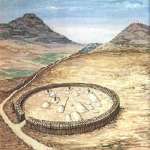
|
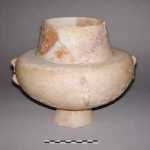
|
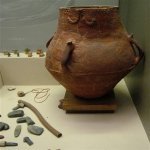
|
Early Bronze Age (3200-2000BC)
The Early Bronze Age is characterised by the spread of metal, the use of which is already known in the Final Neolithic or Chalcolithic period. The Northeastern Aegean, the Cyclades and Mainland Greece are home to specific cultural groups during this period.
Minoan Age (2700 - 1450 BC)
The Minoan civilization was a Bronze Age civilization which arose on the island of Crete. The Minoan culture flourished from approximately 2700 to 1450 BC; afterwards, Mycenaean Greek culture became dominant at Minoan sites in Crete. It was rediscovered at the beginning of the 20th century, at first through the work of the British archaeologist Sir Arthur Evans.
Mycenaean Age (1400-1200BC)
Between 1400 and 1200, Mycenae reached the height of its prosperity and created the most imposing monuments in all Bronze Age Greece. Between 1350 and 1300 the stupendous walls around the citadel were built in their present form; it is significant that such defenses were apparently needed, as they were not (or at least none was built) on Crete. Each city of the Mycenaean period was probably independent under its own king. The only time these cities appear to have united was during the war against Troy, a prosperous city in Asia Minor near the Dardanelles. The origin of the Trojans is not yet clear, but some of their pottery suggest a close relationship to the Greeks. Apparently the Trojans were rich and offered a tempting prospect to pirates and looters. This was probably the real cause of the Trojan War, but ultimately Greeks explained the origins of the war by the romantic story in Homer's Iliad about the seduction by a Trojan of Helen, the wife of the king of Sparta. The excavation of Troy, begun by Schliemann at Hissarlik in Turkey, has disclosed several layers of building. One layer, called Troy VII A, was destroyed by an enemy about 1250. This evidence suggests that Homer's account of a successful Greek expedition against Troy contains some historical truth.

|
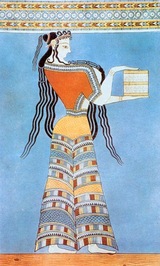
|

|
The Dark Ages (1100-750BC)
During the Dark Ages of Ancient Greece the old major settlements were abandoned (with the notable exception of Athens), and the population dropped dramatically in numbers. Within these three hundred years, the people of Ancient Greece lived in small groups that moved constantly in accordance with their new pastoral lifestyle and livestock needs, while they left no written record behind leading to the conclusion that they were illiterate. Later in the Dark Ages (between 950 and 750 BCE), Greeks relearned how to write once again, but this time instead of using the Linear B script used by the Mycenaeans, they adopted the alphabet used by the Phoenicians “innovating in a fundamental way by introducing vowels as letters. Life was undoubtedly harsh for the Greeks of the Dark ages. However, in retrospect we can identify one major benefit of the period. The deconstruction of the old Mycenaean economic and social structures with the strict class hierarchy and hereditary rule were forgotten, and eventually replaced with new socio-political institutions that eventually allowed for the rise of Democracy in 5th c. BCE Athens. Notable events from this period include the occurrence of the first Olympics in 776, and the writing of the Homeric epics the Iliad and the Odyssey.
Archaic Period (750-480BC)
The Archaic Period in Greece refers to the years between 750 and 480 B.C., more particularly from 620 to 480 B.C. The age is defined through the development of art at this time, specifically through the style of pottery and sculpture, showing the specific characteristics that would later be developed into the more naturalistic style of the Classical period. The Archaic is one of five periods that Ancient Greek history can be divided into; it was preceded by the Dark Ages and followed by the Classical period. The Archaic period saw advancements in political theory, especially the beginnings of democracy, as well as in culture and art. The knowledge and use of written language which was lost in the Dark Ages was re-established.

|
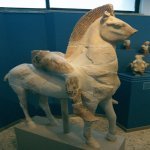
|
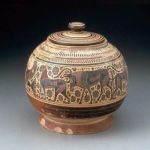
|
Classical Period (500-336 BC)
The Classical Age of Greece begins with the Persian War (490-479 B.C.) and ends with the death of Alexander the Great (323 B.C.). Besides war and conquest, in this period of Ancient Greece, the Greeks produced great literature, poetry, philosophy, drama, and art. Classical Greece includes the period known as the Age of Pericles .
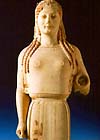
|
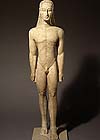
|
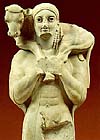
|
Hellenistic Period (336-146 BC)
The death of Alexander the Great in 323 B.C.. marked the beginning of a new stage in world history. Hellenic civilization, properly defined, was now at an end. The fusion of cultures and intermingling of peoples resulting from Alexander's conquests had accomplished the overthrow of most of the ideals represented by the Greeks in their prime. Gradually a new pattern of civilization emerged based upon a mixture of Greek and Oriental elements. To this new civilization, which lasted until about the beginning of the Christian era, the name Hellenistic is the one most commonly applied. While the Hellenistic Age is sometimes regarded as simply a final chapter in the history of Ancient Greece, this is by no means correct. The centuries which followed the death of Alexander were so markedly different from the Golden Age of Greece that they cannot be accurately regarded as a continuation of it.

|
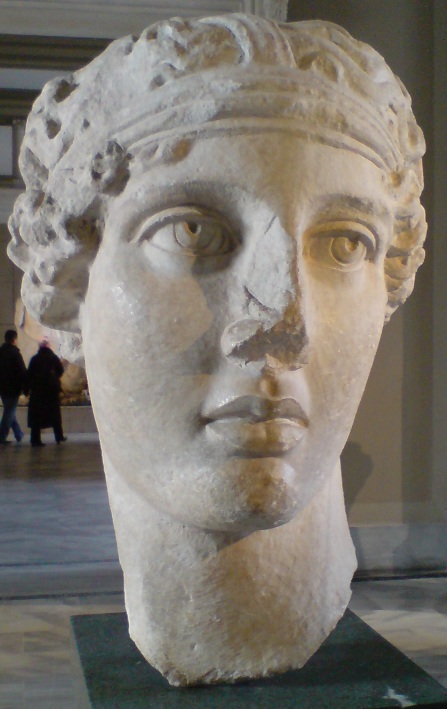
|

|
Click to open the page of more pictures from Ancient Greece









